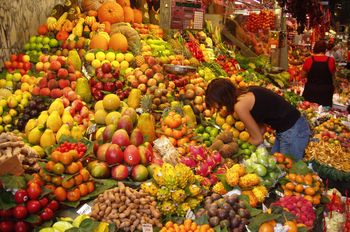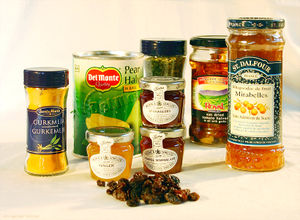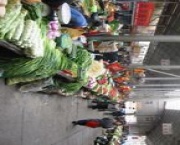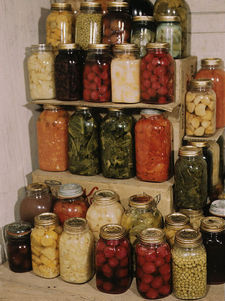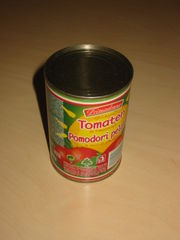Lesson 6: Food Selection, Purchasing and Storage
Contents
- 1 Food Selection,Purchasing and Storage
- 2 Reflection
- 3 Summary
- 4 Assignment
Food Selection,Purchasing and Storage
Introduction
Resources are needed for the selection, purchase and storage of food.A caterer must consider the best use of these resources to produce the best results.This unit will expose you to the many resources that you require for efficient selection, purchase and storage of food in your establishment.It will also expose you to the many techniques you need in the market place and the various ways in which you can store your equipment and food to avoid waste.It will also show you how to deal with advertisements to get the best results.
After studying this unit, you should be able to:
|
| Ama woke up this morning not knowing what to cook for her family. Even though she had all kinds of food commodities in the house, she was in deep thought trying to figure out what to feed her family with. Ama is having a problem of selection, in other words she cannot choose what to give her family.Have you ever found yourself in such a situation? Many of us do a lot of times. |
Selection or choice of food is very important in meal management. Providing food in a manner which is satisfactory to many people can be a complicated issue. Many decisions are required and careful thought and planning is important.
Food Selection
The types of food you select depends on:
- the money you have
- your nutritional needs and
- the effect of advertisements
Now let us examine each of these factors and see how they influence our selection or choice of food!
The money you have
The more money you have the more foods you can buy and the greater your choice. People who have a lot of money can afford a variety of meals and can eat away from home. People with small incomes have a limited choice and it becomes a hard task to buy enough food to meet family needs.
If you have a limited food budget, you can save money by buying foods that in season and buying cheaper cuts of meat as well as comparing prices in different shops.
Likes and dislikes
You eat to keep alive and healthy. At the same time most people also eat to enjoy the food. People tend to eat foods they like and avoid those they dislike.
Is there any food you dislike? Why do you dislike it? Is this food very nutritious?
Foods are normally disliked because:-
Of their colour, flavour and texture They are new and have never been tried They do not look attractive The food is associated with some ill feeling The way it is cooked is not appealing
Food is enjoyed when it is liked. Food is enjoyed because it provides some sensations for you the aromas and flavours that come from food are detected by special nerves in the sense organs of taste and smell. Sight and temperature also have a great effect on the enjoyment of food. Cooking food often develops the flavour and changes the texture of food. Many foods are traditionally eaten hot or cold. If food is too hot or too cold it true flavour may be masked and it may be uncomfortable to eat.
Advertisements
Another great influence on food choice is advertisement.Advertisements have a way of persuading people to make choices. Food manufacturers and shops advertise their products through television, radio, magazines, newspapers, posters and leaflets.
Good adverts are decent, honest and truthful.
They do not mislead the public about a product.
They show a sense of responsibility to people.
They conform to fair competition behaviour different manufacturers and businesses.
Nutritional needs
Your food choice will also depend on your need for food. Everyone has a biological need for food. It is essential for life without food one becomes weak and ill. People vary in the amount of food they need for reasons like health, age and activity.
Your choice of food will therefore depend on each of these factors. Your nutrition knowledge helps you to choose food that provides the necessary nutrients to meet your needs.
Food Purchasing
Food purchasing can be a boring or interesting adventure depending on one’s approach to it. To make food purchasing interesting you have to know much about the market place and ways in which you can make the most out of your food budget.
Now let us look at some of the things you can do to avoid waste of your time and money when purchasing food.
First of all you need to know the factors that determine the cost of the things you want to purchase. *Production cost *The season *The market supply of the goods *The demand of the goods *Advertisements *Amount of processing
Can you explain how each of these affects the cost of the things you buy? Now read the following explanations.
Production cost
This is the amount of money used to produce the item. In the case of food, the production cost will include the money spent on cleaning the land, sowing the seeds, harvesting and processing. The final cost of a product is determined by this amount plus others like transportation cost, profit and handling charges.
The season
Seasonal differences in the cost of food occur frequently in Ghana. Food items always cost less when they are in season because they are plenty and so the supply becomes high. When market supply of a commodity becomes high the price of the commodity falls. Food items that are out of season become scarce and therefore their prices are higher.
Demand for item
Usually when many people want a certain item, its price increases.
Advertisements
These are ways in which manufacturers and sellers tell us they have certain goods and services for sale. Advertisements cost money. The cost of advertising a product is added to the production cost to make up the price of a product. The more the advertisement the higher the cost of the product.
Amount of processing
Processing adds value to products and it costs money. Foods that are processed to provide conveniences cost more than unprocessed ones.
Do you now see why these factors affect the cost of products? Having learnt about these factors how would you buy your commodities so that you do not spend too much money
Factors that determine the amount of money we spend on food.
For most people food budget is one of the largest expenses.Careful planning and shopping can result in substantial savings. Normally if you are rich you tend to spend more money on food and if you are poor you spend less.
- Your skills personal preferences,
- Your values and your lifestyle will all determine your food selection and hence the money you spend buying food.
- The skill of bargaining for example would help you to buy goods at the cheapest possible cost.
- Buying foods in season and in bulk also helps to cut down cost.
- Buying food from farm gates instead of from retailers also cuts cost.When you buy food, buy them from places where prices are lower and where food sold is of good quality.Buy food from places that are clean and where food is well stored.
Forms in which food is sold
Foods are sold in many forms. The form you buy is determined by the storage facilities you have, how much convenience you need and what you want to use the food for. Foods are sold fresh, dried, frozen or canned.
Fresh foods
Fresh foods provide most nutrients since processing may destroy the nutrients. Fresh foods are natural and do not require fortification or processing. They therefore cost less. How ever, because they are fresh they spoil fast.
Frozen foods
Frozen foods are much nearer to fresh foods as far as nutrient content is concerned. Freezing prevents the action of enzymes and microorganisms. Microorganisms are minute organisms which we can not see but which can be very harmful to us and can spoil our food. Frozen foods must be stored in the freezer in useable quantities. Remember that when you thaw a frozen food completely it must be used immediately to avoid spoilage. Thawed foods should not be refrozen.
Dried foods
Dried foods have their moisture removed. Some dried foods like milk powder, can be reconstituted by adding water. Dried foods do not require refrigeration. They are light in weight and take up les storage space.
Canned foods
Canned foods are convenient to use. They will not spoil as long as the can is not punched. Canned foods should be stored in cool dry places. They do not have the taste of freshly cooked foods. They are much more expensive than foods in other forms. They have long shelf life that is they last longer. Unless canned foods are fortified with nutrients they loose most of their nutrient content.
Tips for shopping
When buying food, choose the form that you can easily handle and which you can afford. Make a shopping list so that you buy the things you need without wasting time. 2.Choose the type and location of market appropriate to your needs. 3.Compare prices and quality of commodity before you buy. 4.Buy foods in bulk if you have storage facilities and money. It is cheaper. 5.Do not shop when you are hungry; it makes you buy more than necessary. 6.Do not take children along when you go shopping; they make you buy unnecessary things. 7.Avoid impulse buying, that is buying things you did not plan for. 8.When you buy canned or packaged foods, look out for the expiry date or ‘use by’ date. It is the last day a product is considered fresh. A food may still be safe to eat after this date but the taste and nutrient quality may not be good.
Donts
Do not buy processed foods when the following signs are seen:-
- Cans are bulging or dented because they may cause food poisoning
- Rusty can may contain spoiled food
- Frozen food packages that are soft or soggy may have thawed for a long time and May be spoiling
- Refrozen foods, this can be detected as stained packages or crystallized products
- Opened or damaged packages
- Moldy or coloured dried foods
- Meat or fish that has dull or slimy surface
Some unscrupulous sellers buy products which have expired from the large shops and sell then in the open markets at prices that are cheaper. Check the expiration dates and shapes of such items before you buy them.
Points to bear in mind when purchasing some food commodities
Fruits and vegetables
High quality fruits and vegetables are the ones that are ripe, crisp, fine and free from bruises. Nutrients values of fruits and vegetables decrease over a period therefore you should try to buy those that are fresh. Vegetables will usually wither when kept in the sun or kept for too long.
Starchy roots and plantain
These foods form the staple food in many Ghanaian homes. They are relatively cheap but do not have good keeping quality. They can be used for a variety of food products. They are sold in fresh or dried and powdered forms. Examples of such foods are plantain cassava, yam, cocoyam, water yam, potato and taro.When purchasing these foods care must be taken so that only good quality foods are bought. Roots should be free from bruises since this would make them rot quickly. They must be firm to touch. Softness in roots is a sign of spoilage. They must not start sprouting. Ripped plantain should not have black spots on the skin.
Animal and animal products
Foods in this group are very expensive and they spoil very quickly. The most expensive animal foods are not necessarily the most nutritious. If you have limited resource you can still get good quality protein from cheap sources such as snails, crabs, sprats and anchovies. Bone in beef is just as nutritious as bone less beef.When buying animal foods, quality and safety are very important consideration. You can tell the quality of animal products as follows:- Meat should have a deep red colour with white or creamy fat. Signs of poor quality are very dark brown or green colour and yellow fat. When the meat is greenish and smells bad it is of poor quality and not safe for eating. Poultry should have a meaty body with meaty legs and breasts. The skin should not have any discoloration Fish should have firm flesh and shiny skin with a lot of tightly clinging scales. It must have bright and clear eyes and red shiny gills. Disagreeable colour, flesh that leaves a dent when pressed and dry skin are signs of spoilage.
Before I leave this topic, let me add that tenderness of meat and poultry depend on the age of the animal and the part of animal bought. The nutritive value is, however, not affected by these.
- Eggs
Eggs may have white or brown shells. The nutritive value is the same. Eggs can be bought fresh or dried.
When buying eggs, look for shells that are rough and not shiny. Test for freshness by putting it in a jar of salt water. When it floats the eggs is stale. Buy eggs that are clean and not cracked.
- Milk
Milk is sold in liquid or powdered form. Your choice will depend on what you want to use it for and the storage facility you have. Milk can be bought fresh. Its keeping quality is not good especially outside the refrigerator. When a milk tin is opened and used the remaining milk should be poured out of the tin and kept in the refrigerator or a cool dry place, well covered.
- Legumes
Legumes include groundnuts, cowpeas and soya beans. Legumes are sold shelled or unshelled. They are sold dry or canned.When buying legumes you must buy the ones that are not infested with weevils. Also they must not be mouldy. It is better to make your own groundnut paste than to buy from the market. Often groundnut paste is adulterated before it is sold in the market.
- Cereals
Cereals are normally sold in grains or in powdered form or as breakfast cereal.
When buying cereals avoid the ones that have weevils or have grown moulds. Mouldy cereals are not good for consumption. Make your own corn dough instead of buying from the market.
Food Storage
Food commodities that are purchased from the market must be stored well if they must keep their quality. As soon as you return from the market you need to group your item into the following categories.
- Dry storage items
- Frozen items
- Fresh items
Food is stored mostly because we want to keep it safe and prolong its shelf life. There are three types of food storage.These are:-
- Dry storage
- Refrigerator storage
- Freezer storage
Dry storage
Foods that need to be kept dry are usually stored in cabinets or store rooms. Cereals, canned foods packaged foods and other dry food items should be kept in cool dry and clean places in the kitchen. Food should not be stored above refrigerator or cooker or near any heat outlet. The temperatures of these areas are warm and favourable for the growth of microorganisms. Storage areas must be kept clean so, you should wipe spills as soon as they occur to avoid attracting insects.
Refrigerator storage
Refrigerator temperatures should be between OoC and 7oC. Temperatures in the refrigerator vary depending on the part of the refrigerator. The shelves on the door are not as cold as the inside. This area is good for storing eggs. The lower part of the refrigerator is also not very cold so vegetables can be stored there. Foods stored in the refrigerator must be covered well so that it would not dry out or absorb odours from other foods.
Freezer storage
The temperature of the freezer should be - 18oC or below. Frozen foods their original packages in the freezer. Foods to be frozen should be wrapped in moisture and vapour proof wrapping and arranged properly in the freezer.
After shopping for food, store frozen foods immediately in the freezer, so that they will not thaw completely. After this you can store other foods that need refrigeration like eggs. Wash fresh vegetables before storing in the vegetable compartment of the refrigerator. Store yams, potatoes and onions in a cool dry place.
If fruits are not fully ripe they should be kept at room temperature until they are ripe. Then they can be put in the refrigerator. Do not store bananas in the refrigerator because they darken and do not look attractive.
Canned and packaged foods should be placed in a cool and dry cupboard. When opened they must be refrigerated.
| Food selection, purchase and storage require the use of many resources.The important ones are times, energy, money, storage facilities, knowledge and market.A good market list is required when shopping to avoid waste of resources and impulse buying.When foods are chosen wisely you can save a lot of money while providing adequate meals for yourself. Foods stored properly are safe and last longer. |
a.vegetables b.yams c.maize d.meat
|
